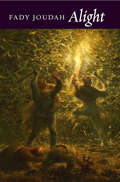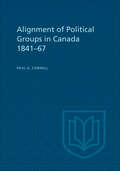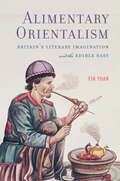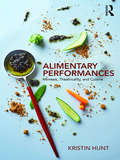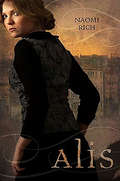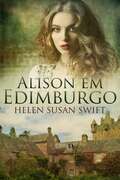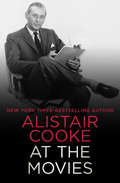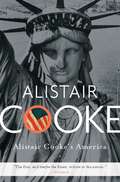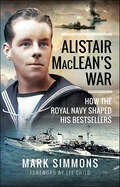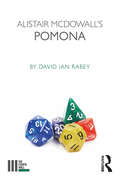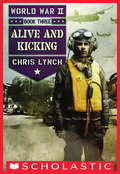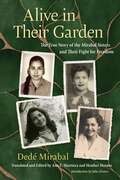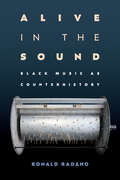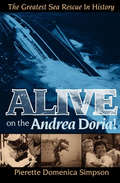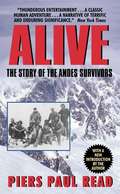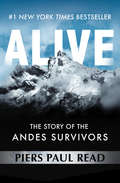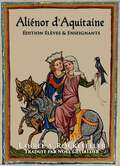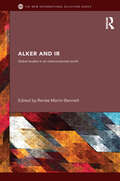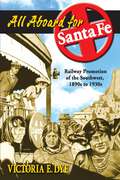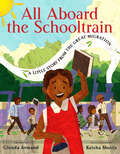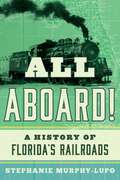- Table View
- List View
Aliens: Mystifying True Stories of Alleged Alien Encounters
by Jamie KingThis intriguing anthology examines incidents that were so puzzling they led witnesses to draw one inevitable conclusion: that aliens really do exist. Inside you will discover some of the most mysterious reports of UFO sightings, close encounters and alien abductions from across the globe.
Aliens: Mystifying True Stories of Alleged Alien Encounters
by Jamie KingThis intriguing anthology examines incidents that were so puzzling they led witnesses to draw one inevitable conclusion: that aliens really do exist. Inside you will discover some of the most mysterious reports of UFO sightings, close encounters and alien abductions from across the globe.
Alight
by Fady JoudahThe poems in Alight alternate between the estranging familial and strangely familiar, between burning and illumination. As father, husband, and physician, Fady Joudah gives children and vulnerable others voice in this hauntingly lyrical collection, where, with quiet ferociousness, one's self can be reclaimed from suffering's grip over mind and spirit.Fady Joudah is a Palestinian-American poet, translator, and physician of internal medicine. He received his medical training from the Medical College of Georgia and University of Texas, and served with Doctors Without Borders in 2002 and 2005. His first book, The Earth in the Attic, won the 2007 Yale Series of Younger Poets competition, judged by Louise Glück. In 2010 he received a PEN translation award for his translations of Palestinian poet Mahmoud Darwish.
Alignment of Political Groups in Canada 1841-67 (Canadian Studies in History and Government)
by Paul G. CornellThe period of the union between the provinces of Upper and Lower Canada which preceded the general federation of the British North American provinces in 1867 is a fruitful field of investigation for students of Canadian politics and history, for from it stem many of our political traditions. Professor Cornell in the present study has been concerned with the question of how far the parties of that time were already identifiable and continuing groups. He has examined the Journals of the Legislative Assembly of the Province of Canada for all the sessions from 1841 to 1866, recording the votes of each member in all divisions that involved important issues, and from this careful and extensive study he has been enabled to draw some definite conclusions about the alignment of members and groups in the assembly.<p><P>The analysis proceeds not only by way of narrative but also by means of many charts and tables showing the votes of individual members on certain key issues from assembly to assembly. The author defines as far as possible the political outlook or affiliation of the individuals dealt with, and assesses the cohesion of the Radical and Conservative groups in Canada West and the Bleus and Rouges of Canada East. The result is an important contribution to our knowledge of the political groupings and of the political battles of the era, presented in the close detail that will make it an invaluable work of reference for all those working in the period.
Alimentary Orientalism: Britain’s Literary Imagination and the Edible East (Transits: Literature, Thought & Culture, 1650-1850)
by Yin YuanWhat, exactly, did tea, sugar, and opium mean in eighteenth- and nineteenth-century Britain? Alimentary Orientalism reassesses the politics of Orientalist representation by examining the contentious debates surrounding these exotic, recently popularized, and literally consumable things. It suggests that the interwoven discourses sparked by these commodities transformed the period’s literary Orientalism and created surprisingly self-reflexive ways through which British writers encountered and imagined cultural otherness. Tracing exotic ingestion as a motif across a range of authors and genres, this book considers how, why, and whither writers used scenes of eating, drinking, and smoking to diagnose and interrogate their own solipsistic constructions of the Orient. As national and cultural boundaries became increasingly porous, such self-reflexive inquiries into the nature and role of otherness provided an unexpected avenue for British imperial subjectivity to emerge and coalesce.
Alimentary Performances: Mimesis, Theatricality, and Cuisine
by Kristin HuntA pea soda. An apple balloon. A cotton candy picnic. A magical mole. These are just a handful of examples of mimetic cuisine, a diverse set of culinary practices in which chefs and artists treat food as a means of representation. As theatricalised fine dining and the use of food in theatrical situations both grow in popularity, Alimentary Performances traces the origins and implications of food as a mimetic medium, used to imitate, represent, and assume a role in both theatrical and broader performance situations. Kristin Hunt's rich and wide-ranging account of food's growing representational stakes asks: What culinary approaches to mimesis can tell us about enduring philosophical debates around knowledge and authenticity How the dramaturgy of food within theatres connects with the developing role of theatrical cuisine in restaurant settings Ways in which these turns toward culinary mimeticism engender new histories, advance new epistemologies, and enable new modes of multisensory spectatorship and participation. This is an essential study for anyone interested in the intersections between food, theatre, and performance, from fine dining to fan culture and celebrity chefs to the drama of the cookbook.
Alis
by Naomi RichAt fourteen, Alis has never been outside her strict religious community. But when her parents arrange for her to marry a forty-year-old man, she flees desperately to the dangerous, unfamiliar city. She learns quickly that the only way to survive there is to become a thief?or worse. Facing an impossible choice between a forced marriage or life on the streets, Alis seizes control of her own fate. But the path she chooses sets off a disastrous chain of events that leave her accused of murder. Steadfastly loyal, Alis must decide: will she betray a loved one or sacrifice herself?
Alison Em Edimburgo
by Claudia Magalhães Motta Helen Susan SwiftVinda das Highlands escocesas para Edimburgo em busca de um marido, Alison Lamont se mete em todo tipo de apuros. Obrigada a se retirar do elegante baile de Lady Forres por causa de um beijo roubado, ela tem que escapar de um tumulto na famosa Cidade Velha e acaba passando a noite na cabana de Willie Kemp, um excêntrico construtor de barcos. O problema é que, enquanto Alison fica perdidamente apaixonada pelo Sr. Kemp, sua tia quer que ela se case com o repugnante, mas rico, John Forres. Alison toma medidas drásticas para resolver seu dilema, incluindo uma longa viagem por Pentland Hills, uma região coberta de neve. Mas de quem serão as misteriosas pegadas do lado de fora de seu chalé e qual o segredo que o Sr. Kemp está escondendo?
Alistair Cooke at the Movies
by Alistair CookeA wonderful entertainment that reflects Alistair Cooke&’s love affair with cinema, from his early days as a film critic to his iconic role as the host of Masterpiece Theatre Humphrey Bogart, Fred Astaire, Lauren Bacall, Marlene Dietrich, and Marilyn Monroe are just a few of the stars profiled, along with many directors, in this sparkling and comprehensive collection of reviews, interviews, and essays. Alistair Cooke&’s first radio talk at the BBC was in October 1934, and the subject was cinema. He had begun reviewing films in the 1920s as a Cambridge undergraduate. This anthology of his best film criticism and essays includes his many favorite subjects. In &“The Symbol Called Garbo,&” Cooke reveals the woman behind the enigmatic screen goddess. James Cagney is identified as &“one of the few technically perfect actors,&” while Charlie Chaplin was &“the funniest clown alive.&” Shirley Temple&’s multi-million-dollar appeal is explained, as is the subtlety underpinning the slapstick humor of the Marx Brothers. Directors such as Frank Capra, Fritz Lang, and Cecil B. DeMille meet with Cooke&’s high praise, while Alfred Hitchcock evokes a more complicated reaction. Full of glamorous stars, provocative opinions, and fond memories, Alistair Cooke at the Movies is a very personal and captivating guide to the golden age of Hollywood and beyond.
Alistair Cooke's America
by Alistair CookeFirst published in 1973, this follow-up to Alistair Cooke’s acclaimed 1972 television documentary series America: A Personal History of the United States has sold almost two million copies. From the nation’s discovery to modern times; from the American revolutionaries to the pioneers who forged westward; from the slaves who fled north to the immigrants that sought a new life, Cooke vividly describes the spirit of the United States. Cooke’s portrayal of America’s dynamic history and its ever-changing present continues to provide striking insights into the remarkable character of a nation.
Alistair MacLean's War: How the Royal Navy Shaped his Bestsellers
by Mark SimmonsIt is no coincidence that many of Alistair MacLean's most successful novels were sea stories. In 1941, he was called up after volunteering for the Royal Navy and served as Ordinary Seaman, Able Seaman, and Leading Torpedo Operator. For the majority of his service, he was on HMS Royalist, a modified Dido-class light cruiser, seeing action in the Arctic, and operations against the German battleship Tirpitz . The ship then deployed to the Mediterranean taking part in Operation Dragoon the invasion of the South of France and later in operations against German occupied Greek Islands in the Aegean. After which MacLean and Royalist were deployed to the Indian Ocean and operations against the Japanese in Malaya, Burma, and Sumatra. His wartime experiences coupled with exceptional literary skill resulted in the runaway success of his first novel HMS Ulysses (1955) followed by The Guns of Navarone (1957) and South by Java Head (1958). These three blockbusters cemented his position as one of the most successful and highly paid authors of the era. While not a whole life biography, Mark Simmon’s book provides a fascinating insight into Maclean’s war service and subsequent works, which deserve enduring popularity.
Alistair McDowall's Pomona (The Fourth Wall)
by David Ian Rabey‘It’s all real. All of it. Everything bad is real’ - Moe Alistair McDowall’s Pomona was first staged in 2014 and won properly startling, and startled, acclaim. Its edgeland setting permits a surrealistic disengagement of linear forms of time, which is both dreamlike and wildly funny; nightmarish and ominously enveloping. The play has as its imaginative springboard a landscape which is both real and surreal. It offers an unforgettable journey into radical uncertainty, alongside unpredictable action that presents and questions the forms by which all too much of British life is lived. Rabey offers us a wild plunge into this modern English urban rabbit hole, a haunting and bewildering high-stakes hunt for meaning and value, set in a gothic noir Manchester, possibly dystopian (or possibly not).
Alive and Kicking: Alive and Kicking (World War II #3)
by Chris LynchThe author of the acclaimed Vietnam series sets his sights on World War II."All the sizzle, chaos, noise and scariness of war is clay in the hands of ace storyteller Lynch." -- Kirkus ReviewsTheo has always looked up to his older brother, Hank, but never more so than the day Hank enlisted in the US Navy. Not to be outdone, Theo followed his older brother's lead in joining the war effort -- but preferring the wide open sky to the untamed ocean, Theo chose to serve with the Army Air Force.As a gunner on a B-24 Liberator, Theo is enthusiastic about his crew's mission to save all of Europe from the Nazis. Fearlessness is a requirement for dog fights at 50,000 feet. But when Theo's brother goes missing in the Pacific, fear start creeping in. Can Theo keep his head in the game while he awaits word of his brother's fate?
Alive in Christ- Our Sunday Visitor School 3
by Steven PinkerThis year you will learn a lot, about the Church, the community of all baptized who believe in God and follow Jesus Christ. Important words like this are Highlighted in yellow so you don't miss them.
Alive in Their Garden: The True Story of the Mirabal Sisters and Their Fight for Freedom
by Dedé MirabalThe lives and legacy of the iconic Mirabal sisters, as told in an intimate memoir by the sister who survived In 1960, the three sisters Patria, Minerva, and María Teresa Mirabal, code-named “Las Mariposas” (The Butterflies) by a Dominican underground resistance movement, were assassinated by order of dictator Rafael Trujillo. Alive in Their Garden is the memoir of Dedé Mirabal, their surviving sister, who for decades kept her sisters alive in Dominican memory. This is the first English translation of Dedé’s story, an intimate account of a tragedy and the international outcry that, for many, heralded the fall of the Trujillo dictatorship. In her memoir, Dedé recollects her sisters’ lives and personalities, the optimistic beginning of the 14th of June Revolutionary Movement, and the tragic day of her sisters’ murders. She details the emotionally charged court proceedings that followed and the impact these events had not only on the Mariposas’ children and family but on the world. Along her journey, Dedé grapples with the question, “Why did they not kill you too?” And as time goes on, she comes to recognize her own important role: raising her sisters’ children alongside her own and working to preserve the memory of a generation. This edition features the memoir’s original introduction by Julia Alvarez, author of In the Time of the Butterflies, a chronology by historian Bernardo Vega, and an afterword by Minerva’s daughter Minou Tavárez Mirabal. Adding a preface and explanatory notes that orient readers to the Trujillato in the Dominican Republic, translators and editors Ana Martínez and Heather Hennes bring a moving true story and valuable piece of history to new readers.
Alive in the Sound: Black Music as Counterhistory (Refiguring American Music)
by Ronald RadanoIn Alive in the Sound, Ronald Radano proposes a new understanding of US Black music by focusing on the key matter of value, manifested musically in its seemingly embodied qualities—spirit, soul, and groove. While acknowledging these qualities are always embedded in Black music, Radano shows they developed not simply from performance but from musicians’ status as laborers inhabiting an enduring racial-economic contradiction: Black music originated publicly as an exchangeable property owned by people whose subhuman status granted them—as “natural” musicians—indelible properties of sound. As a contradiction of the rules of ownership, wherein enslaved property was forbidden the right to own, modern Black music emerges after emancipation as a primary possession, moving dialectically into commercial markets and counterhistorically back into Black worlds. Slavery’s seminal contests of ownership underlie modern musical sensations of aliveness, which become the chief measure of value in popular music. By reconceiving US Black music history as a history of value, Radano rethinks the music’s place in US and global culture.
Alive on the Andrea Doria!: The Greatest Sea Rescue in History
by Pierette Domenica SimpsonA breathtaking minute-by-minute account of the most catastrophic tragedy-at-sea since the sinking of the Titanic—told by a survivor. More than one half-century later, the catastrophic ramming of the MS Stockholm into the Italian luxury liner, the SS Andrea Doria in 1956, is relived in this candid, heartrending account. Author Pierette Domenica Simpson, who, with her grandparents, survived the tragedy off the shoals of Nantucket, shares the human and technical aspects of what has become known as the greatest sea rescue in history. As only an eyewitness can do, Simpson shares the survivors&’ harrowing recollections that meticulously recreate the terrifying and heart-wrenching tragedy that united poor immigrants and wealthy travelers alike. They give their accounts of ultimate despair and infinite elation after staring at their own reflections in the black ocean that night and seeing death stare back. Equally dramatic are the revelations of new facts exposed by nautical experts from two continents that finally solve the mystery of who was to blame for this most improbable collision between two random ships on the open Atlantic.
Alive: The Story of the Andes Survivors
by Piers Paul ReadTrue story about how a group of people who survived an airplane crash in the Andes had to resort to cannibalism in order to stay alive. Copyright © Libri GmbH. All rights reserved.
Alive: The Story of the Andes Survivors (P. S. Series)
by Piers Paul Read#1 New York Times Bestseller: The true story behind Netflix&’s Society of the Snow—A rugby team resorts to the unthinkable after a plane crash in the Andes. Spirits were high when the Fairchild F-227 took off from Mendoza, Argentina, and headed for Santiago, Chile. On board were forty-five people, including an amateur rugby team from Uruguay and their friends and family. The skies were clear that Friday, October 13, 1972, and at 3:30 p.m., the Fairchild&’s pilot reported their altitude at 15,000 feet. But one minute later, the Santiago control tower lost all contact with the aircraft. For eight days, Chileans, Uruguayans, and Argentinians searched for it, but snowfall in the Andes had been heavy, and the odds of locating any wreckage were slim. Ten weeks later, a Chilean peasant in a remote valley noticed two haggard men desperately gesticulating to him from across a river. He threw them a pen and paper, and the note they tossed back read: &“I come from a plane that fell in the mountains . . .&” Sixteen of the original forty-five passengers on the F-227 survived its horrific crash. In the remote glacial wilderness, they camped in the plane&’s fuselage, where they faced freezing temperatures, life-threatening injuries, an avalanche, and imminent starvation. As their meager food supplies ran out, and after they heard on a patched-together radio that the search parties had been called off, it seemed like all hope was lost. To save their own lives, these men and women not only had to keep their faith, they had to make an impossible decision: Should they eat the flesh of their dead friends? A remarkable story of endurance and determination, friendship and the human spirit, Alive is the dramatic bestselling account of one of the most harrowing quests for survival in modern times. &“A classic in the literature of survival.&” —Newsweek
Aliénor d'Aquitaine: Édition Élèves & Enseignants (Femmes Légendaires de l'Histoire du Monde #13)
by Laurel A. RockefellerJeune fille, Aliénor était le parti le plus recherché de toute la Chrétienté… et pas seulement à cause de sa beauté. Fille aînée du duc Guillaume X d'Aquitaine, elle avait hérité de son immense duché à l'âge de 15 ans et fut couronnée reine des Francs la même année. Mais l'amour ne fut pas au rendez-vous pour cette magnifique duchesse, malgré deux mariages et dix enfants. Pourtant les troubadours chantèrent ses louanges, composèrent pour elle les premières chansons d'amour courtois, et c'est en son honneur que furent déclamées pour la première fois les légendes du roi Arthur et des chevaliers de la table ronde. Aliénor façonna deux empires naissants et fit de l'Aquitaine l'alliée de l'Angleterre la plus fiable sur le continent. Aliénor d'Aquitaine fut une légende à son époque, elle l'est encore à la nôtre. Voici son histoire. L'édition Élèves & Enseignants contient un guide d'étude après chaque chapitre.
Alker and IR: Global Studies in an Interconnected World (New International Relations)
by Renée Marlin-BennettInternational Relations have rarely been considered a synthesis of humanistic and social sciences approaches to understand the complex connections of a global, and globalizing, world. One of the few scholars to have accomplished this creative blend was Hayward R. Alker. Alker and IR presents a set of visionary and original essays from scholars who have been profoundly influenced by Alker's approach to global studies. They build on the foundation he laid, demonstrating the practicality and usefulness of ethically grounded, theoretically informed and interdisciplinary research for producing knowledge. They show how substantive boundaries can be crossed and methodological rules rewritten in the search for a deeper, more contextualized approach to global politics. This book will be of interest to researchers and students of international relations and global politics.
All Aboard for Santa Fe: Railway Promotion of the Southwest, 1890s to 1930s
by Victoria E. DyeBy the late 1800s, the major mode of transportation for travelers to the Southwest was by rail. In 1878, the Atchison, Topeka, and Santa Fe Railway Company (AT&SF) became the first railroad to enter New Mexico, and by the late 1890s it controlled more than half of the track-miles in the Territory. The company wielded tremendous power in New Mexico, and soon made tourism an important facet of its financial enterprise.All Aboard for Santa Fe focuses on the AT&SF's marketing efforts to highlight Santa Fe as an ideal tourism destination. The company marketed the healthful benefits of the area's dry desert air, a strong selling point for eastern city-dwelling tuberculosis sufferers. AT&SF also joined forces with the Fred Harvey Company, owner of numerous hotels and restaurants along the rail line, to promote Santa Fe. Together, they developed materials emphasizing Santa Fe's Indian and Hispanic cultures, promoting artists from the area's art colonies, and created the Indian Detours sightseeing tours. All Aboard for Santa Fe is a comprehensive study of AT&SF's early involvement in the establishment of western tourism and the mystique of Santa Fe.
All Aboard for Yesterday! A Nostalgic History of Railroading in Maine
by J. Malcolm BarterForty essays on every aspect of Maine rail-roading through the years, from the "Lion" to the narrow gauge lines, from the ferries and bridges to the fast mails and plush varnish.
All Aboard the Schooltrain: A Little Story from the Great Migration
by Glenda Armand"Schooltrain! Schooltrain! Don't be late! The school bell rings at half past eight!"This tender family story, inspired by the author's own, illuminates a dynamic chapter in American history known as the Great Migration - and the many trains people rode toward freedom.* "A vivid evocation of place and era rolling solidly on a bed of timeless values." - Kirkus Reviews, starred review* "A child-friendly picture book introducing the Great Migration." - Booklist, starred reviewThelma loves to watch the Sunset Limited chug through her little town of Vacherie, Louisiana. And she dreams of one day riding a real train! For now, she has her beloved schooltrain. Every morning, she and her friends walk to school, single file, chanting all the way:"Schooltrain! Schooltrain! Don't be late! The school bell rings at half past eight!"Then it's on to great adventures with her teacher's books - and her own imagination!But lately, someone named Jim Crow has been making trouble for folks in Vacherie. Aunt Bea and Uncle Ed have already moved away. When Thelma's best friend also has to leave, Thelma wonders, who is Jim Crow and why does he have to be so mean? Will he make trouble for Pop, too?
All Aboard!: A History of Florida's Railroads
by Stephanie Murphy-LupoFlorida's size and shape meant a largely remote interior until shortly before the Civil War. The catalysts for blasting through that anonymity were three ambitious and very different visionaries who built railroads linking east to west and north to south: Henry Morrison Flagler, David Levy Yulee, and Henry Bradley Plant. Their iron horses transported people––rich tourists from New York, slaves from Africa sold in Havana––and goods from around the state and the globe: oysters, cattle, sugar cane, molasses, and phosphate. Versions of the main lines run today––hauling freight in and out of the state and carrying passengers to connecting lines nationwide. Yet Florida&’s size and shape still get in the way of efficient auto trips and affordable inter-state air travel. A private company is today planning to build a high-speed passenger train from Miami to Orlando. This book is the complete history of railways in the state of Florida––telling the tale of its beginnings as well as its future.

